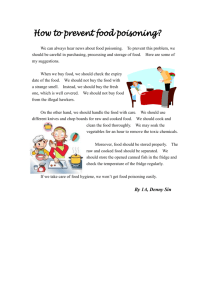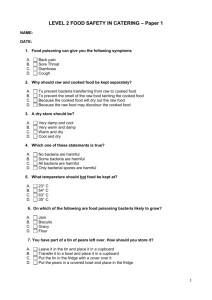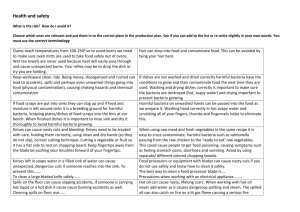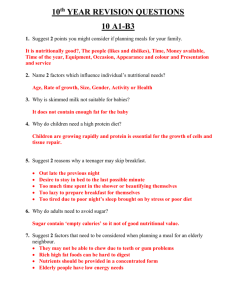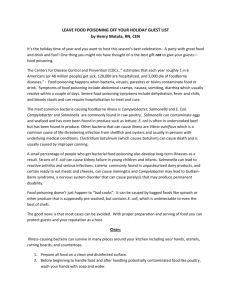FAQ`s - City of Cape Town
advertisement
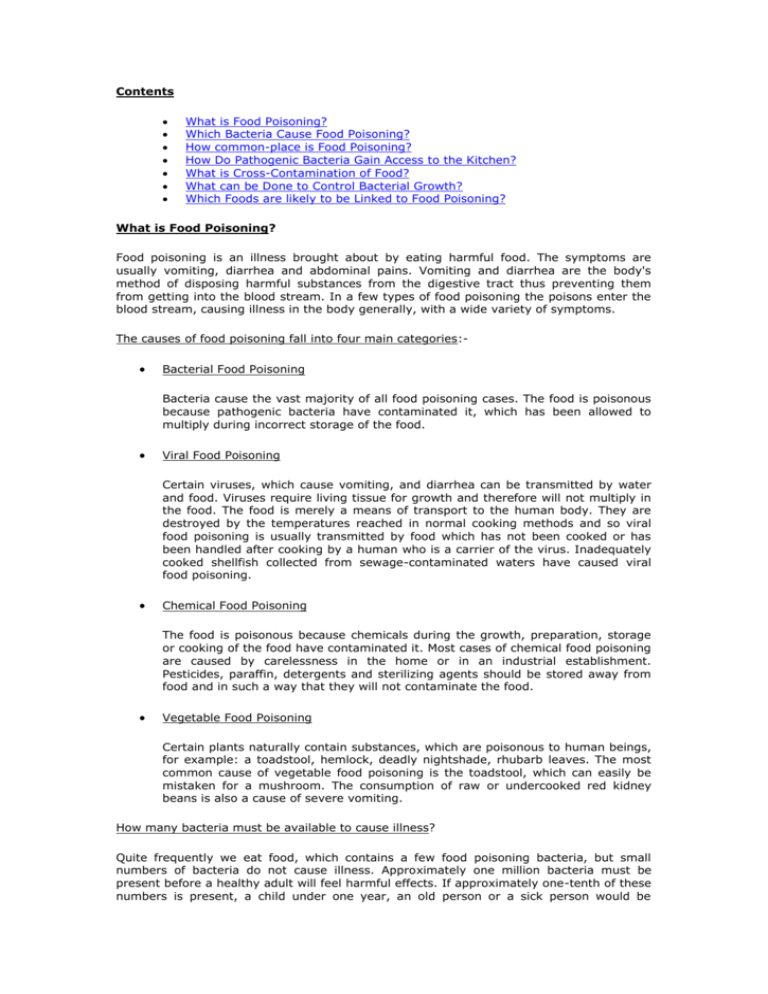
Contents What is Food Poisoning? Which Bacteria Cause Food Poisoning? How common-place is Food Poisoning? How Do Pathogenic Bacteria Gain Access to the Kitchen? What is Cross-Contamination of Food? What can be Done to Control Bacterial Growth? Which Foods are likely to be Linked to Food Poisoning? What is Food Poisoning? Food poisoning is an illness brought about by eating harmful food. The symptoms are usually vomiting, diarrhea and abdominal pains. Vomiting and diarrhea are the body's method of disposing harmful substances from the digestive tract thus preventing them from getting into the blood stream. In a few types of food poisoning the poisons enter the blood stream, causing illness in the body generally, with a wide variety of symptoms. The causes of food poisoning fall into four main categories:- Bacterial Food Poisoning Bacteria cause the vast majority of all food poisoning cases. The food is poisonous because pathogenic bacteria have contaminated it, which has been allowed to multiply during incorrect storage of the food. Viral Food Poisoning Certain viruses, which cause vomiting, and diarrhea can be transmitted by water and food. Viruses require living tissue for growth and therefore will not multiply in the food. The food is merely a means of transport to the human body. They are destroyed by the temperatures reached in normal cooking methods and so viral food poisoning is usually transmitted by food which has not been cooked or has been handled after cooking by a human who is a carrier of the virus. Inadequately cooked shellfish collected from sewage-contaminated waters have caused viral food poisoning. Chemical Food Poisoning The food is poisonous because chemicals during the growth, preparation, storage or cooking of the food have contaminated it. Most cases of chemical food poisoning are caused by carelessness in the home or in an industrial establishment. Pesticides, paraffin, detergents and sterilizing agents should be stored away from food and in such a way that they will not contaminate the food. Vegetable Food Poisoning Certain plants naturally contain substances, which are poisonous to human beings, for example: a toadstool, hemlock, deadly nightshade, rhubarb leaves. The most common cause of vegetable food poisoning is the toadstool, which can easily be mistaken for a mushroom. The consumption of raw or undercooked red kidney beans is also a cause of severe vomiting. How many bacteria must be available to cause illness? Quite frequently we eat food, which contains a few food poisoning bacteria, but small numbers of bacteria do not cause illness. Approximately one million bacteria must be present before a healthy adult will feel harmful effects. If approximately one-tenth of these numbers is present, a child under one year, an old person or a sick person would be affected. Special care must therefore be taken when preparing food for people in these categories. Food poisoning is occasionally fatal. The deaths caused by food poisoning are usually in very young babies or in old or severely ill people. Incubation period This is the time that passes between the entry of the poisonous food into the body and the occurrence of the first symptoms. The length of the incubation period helps to decide which type of bacteria has caused the food poisoning. Some types of bacteria cause food poisoning with a relatively long incubation period (up to 2 days) and other types of bacteria cause food poisoning with a relatively short incubation period (2 hours). The length of the incubation period also depends on the number of bacteria present as well as the type of bacteria causing the food poisoning. If the food is very heavily contaminated with a certain type of bacteria, the incubation period will be shorter than if the food is only contaminated with only half the number of the same type of bacteria. Duration of illness The duration of the illness is the time between the appearance of the first symptoms of food poisoning and the clearing up of the last ones. When all the symptoms of the food poisoning have gone, it does not necessarily mean that there are no harmful bacteria in the intestinal tract but that the numbers present are no longer sufficient to produce symptoms. Which bacteria causes food poisoning? The following bacteria are known to cause food poisoning:- Salmonella Staphylococcus aureus Clostridium perfringens Clostridium botulinum Bacillus cereus How common is food poisoning? There are a number of reasons for this increase:- The practice of eating out is becoming far more popular and the majority of the working population is eating at least one meal a day in a restaurant, pub or canteen. If a mistake is made in food preparation in one of these catering establishments a large number of people will be affected, whereas a similar incident in the home will only affect a small number of people. Restaurants, canteens etc. produce a much more varied range of dishes than used to be the case. With this degree of choice, instead of food being served hot immediately after it is cooked, there is tendency to keep foods warm until a customer requests a particular dish. Many housewives now work full-time, hence shopping is probably done weekly rather than daily, resulting in a greater chance of bacterial growth in the food after purchase unless it is stored correctly. The majority of outbreaks of food poisoning occur during the summer months. In the summer, there is an increased tendency to pack foods, e.g. for picnics or long journeys. These are often kept at incorrect temperatures for several hours before they are eaten. Large-scale production of food for weddings, Christmas or other functions, where the food is prepared the day prior to the function, is not stored correctly and also not adequately re-heated before serving. How do pathogenic bacteria gain access to the kitchen? Pathogenic bacteria obtain access to the kitchen in one of the following ways:- Raw Meat Animals and poultry frequently carry pathogenic bacteria in their intestines. When the animals are slaughtered, these bacteria may spread over the surface of the meat where they will grow and multiply rapidly unless the meat is refrigerated immediately and kept under refrigeration during transport and storage in the butcher shop. If these storage rules are observed the bacteria on contaminated meat will remain dormant, but they will be able to grow and multiply again as soon as the meat is removed from refrigerated storage into normal room temperatures. However reputable the supplier, raw meat often carries small numbers of pathogenic bacteria. These will normally be killed in the cooking process, but care must be taken by the food handler not to let them have a chance to multiply and not to let them spread to foods, which have already been cooked. Food handlers Pathogenic bacteria from food handlers can be spread into food, usually via the hands, during preparation and service. Everybody carries bacteria in their mouth, nose, intestine and on their skin and some of these bacteria will inevitably be transferred to the food. Animals and Insects Flies, rats, mice, birds, other insects and animals including pets frequently carry pathogenic bacteria in their intestines and on their feet and fur and must therefore not be allowed to come into contact with food or equipment which will be used for food preparation. Dust Soil contains spores of some of the pathogenic bacteria. Raw vegetables must therefore always be cleaned thoroughly in a section of the kitchen used only for this purpose and then transferred to another section for further preparation. What is Cross-contamination of food? Cross-contamination is the transfer of bacteria from a contaminated source to an uncontaminated food (usually freshly cooked food). If this food is suitable for bacterial growth and is left for some time in a warm room, the few bacteria, which have been transferred to it, will multiply to large numbers and when the food is eventually eaten it may cause food poisoning. If the original contaminated source was a raw food, it will not usually be a cause of food poisoning because cooking later destroys the bacteria present. Bacteria can be transferred from a contaminated source to an uncontaminated food by:- Using a chopping board, a working surface or other kitchen equipment for the preparation of two different foods without washing it thoroughly between each use. Using a knife or other utensil without washing it thoroughly between each use. The hands of a food handler which are not washed in between preparing different types of food, e.g. raw and cooked meat, or after touching any source of bacteria, e.g. the nose, mouth, hair, pets. Incorrect positioning of foods in the refrigerator. For example, raw meat must always be placed below cooked food so that blood (which often contains pathogenic bacteria) cannot drip onto the cooked food. Examples of cross-contamination:- A meat mincer which has been used for raw meat and then for cooked corned beef. A knife, which has been used for cutting raw meat and not washed thoroughly before it, is used for slicing cooked meat. A chef develops a heavy cold but does not report it to his employer and continues to work as usual on the preparation of food. Uncooked steak is placed on the top shelf of the refrigerator and uncovered roast chicken on the bottom shelf. What can be done to control bacterial growth in food? The following precautions should be taken so that if some pathogenic bacteria were originally present in the food or have inadvertently entered during preparation, they will be prevented from multiplying. Thaw all frozen meat completely before cooking It is essential that all frozen meats (particularly poultry) should be thawed completely before commencing cooking. If ice is present in the centre of meat it will take far longer for the internal temperature to reach that of the external temperature than in completely defrosted meat. Cook food thoroughly Food is a poor conductor of heat and it takes a long time before the temperature in the centre reaches the same temperature as at the surface. Meat and meat products should never be partly cooked one day and the cooking process finished the next day. If the food is only partly cooked it is likely that bacteria will still be alive, and even if it is stored in a refrigerator there will be time for bacteria to multiply during the cooling down process and the second heating process. If food has been deep frozen and thawed it must not be re-frozen. Deep freeze temperatures do not often kill bacteria and when the food is thawed they will have a chance to multiply. If the food is then re-frozen, a greatly increased number of bacteria will be present, all capable of multiplying the next time the food is thawed. Cool food quickly and keep it cold until it is ready to be served or reheated. All foods should be cooled as quickly as possible so those harmful bacteria will have only a short time at a temperature at which they can multiply. Cooked food should not be taken straight from the oven and put into the refrigerator, however, as this will increase the temperature of the refrigerator to a dangerously high level, and food poisoning bacteria may be able to multiply in other foods being stored there. Place hot cooked foods in a cold room for approximately one-hour and then put in the refrigerator (approx 5 °C). Never keep food warm Keep food either very hot or very cold. Do not keep it in a warm atmosphere e.g. a service counter, as this will allow the rapid multiplication of bacteria. If food is to be served hot it should be served as soon as possible after cooking and provided the temperature is kept above 65 °C there is little danger of bacteria multiplying. If food is to be served cold, it should be stored in a refrigerator until just before it is served. Never reheat food more than once Re-heating food is always a hazard because cooked food may still contain spores of Clostridium perfringens or Bacillus cereus or it may have been contaminated with any type of bacteria after cooking. When the food is cooled the spores will germinate and start to multiply with any other bacteria present. When the food is warmed up, the temperatures used are not normally high enough to destroy toxins or to kill spore-forming bacteria. What Foods are most likely to be Linked to food poisoning? Some foods favour the growth of food poisoning bacteria; others do not. When food poisoning is confirmed it is not always easy to identify the food which has caused the outbreak as there is frequently none of the suspected food left. However, certain foods are regarded as being “high-risk” and if eaten just before the illness, will be suspected as the cause. In some of the investigated outbreaks sufficient evidence is available to implicate one particular food. High-risk foods Foods that encourage the growth of bacteria are usually high in protein and moisture. Examples are meat, poultry, eggs, milk and any foods where these are ingredients. Low-risk foods Certain foods do not normally cause food poisoning because they do not provide bacteria with the nutrients they require for growth and multiplication. Foods with a high concentration of sugar, salt, acid or fat or dry foods will not support the growth of food poisoning bacteria.
